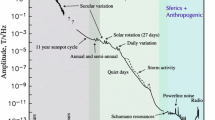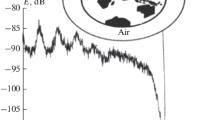Abstract
Most electrical activity in vertebrates and invertebrates occurs at extremely low frequencies (ELF), with characteristic maxima below 50 Hz. The origin of these frequency maxima is unknown and remains a mystery. We propose that over billions of years during the evolutionary history of living organisms on Earth, the natural electromagnetic resonant frequencies in the atmosphere, continuously generated by global lightning activity, provided the background electric fields for the development of cellular electrical activity. In some animals, the electrical spectrum is difficult to differentiate from the natural background atmospheric electric field produced by lightning. In this paper, we present evidence for the link between the natural ELF fields and those found in many living organisms, including humans.





Similar content being viewed by others
References
Adair RK (1991) Constraints on biological effects of weak extremely-low-frequency electromagnetic fields. Phys Rev A 43(2):1039
Balser M, Wagner CA (1960) Observations of the earth-ionosphere cavity resonances. Nature 188:638–642
Banquet JP (1973) Spectral analysis of the EEG in meditation. Electroencephalogr Clin Neurophysiol 35:143–151
Benzi R, Sutera A, Vulpiani A (1981) The mechanism of stochastic resonance. J Phys A Math Gen 14(11):L453–l457. https://doi.org/10.1088/0305-4470/14/11/006
Binhi VN, Rubin AB (2007) Magnetobiology: the kT paradox and possible solutions. Electromagn Biol Med 26(1):45–62
Blake H, Gerard RW, Kleitman N (1939) Factors influencing brain potentials during sleep. J Neurophysiol 2. https://doi.org/10.1152/jn.1939.2.1.48
Blekhman I (1988) Synchronization in science and technology. ASME Press, New York
Bosinger T, Haldoupis C, Belyaev PP, Yakunin MN, Semenova NV, Demekhov AG, Angelopoulos V (2002) Spectral properties of the ionospheric Alfven resonator observed at a low-latitude station (L = 1.3). J Geophys Res 107(A10):1281–1289
Bullock TH (2002) Biology of brain waves: natural history and evolution of an informationrich sign of activity. K. Arikan, N. Moore (Eds.), Advances in Electrophysiology in Clinical Practice and Research, Kjellberg, Wheaton, IL
Bulsara AR, Gammaitoni L (1996) Tuning in to noise. Phys Today 49(3):39–45
Cherry NJ (2002) Schumann resonances, a plausible biophysical mechanism for the human health effects of solar/geomagnetic activity. Nat Hazards 26:279–331
Cherry NJ (2003) Human intelligence: the brain, and electromagnetic system synchronized by the Schumann resonance signal. Med Hypotheses 60(6):843–844
Christian HJ et al (2003) Global frequency and distribution of lightning as observed from space by the Optical Transient Detector. J Geophys Res 108(D1):4005–4010
Cummer S (2000) Modeling electromagnetic propagation in the earth-ionosphere waveguide. IEEE Trans Antennas Propag 48:1420–1429
Dehaene S (1993) Temporal oscillations in human perception. Psychol Sci 4:264–270
Del Giudice E, Fleischmann M, Preparata G, Talpo G (2002) On the “unreasonable” effects of ELF magnetic fields upon a system of ions. Bioelectromagnetics 23(7):522–530
Elhalael G, Price C, Fixler D, Shainberg A (2019) Cardioprotection from stress conditions by weak magnetic fields in the Schumann resonance band. Sci Rep 9:1–10. https://doi.org/10.1038/s41598-018-36341-z
Elson RC, Selverston AI, Huerta R, Rulkov NF, Rabinovich MI, Abarbanel HDI (1998) Synchronous behavior of two coupled biological neurons. Phys Rev Lett 81:5692–5695
Engelmann W, Hellrung W, Johnsson A (1996) Circadian locomotor activity of Musca flies: recording method and effects of 10 Hz square-wave electric fields. Bioelectromagnetics 17:100–110
Fedorov E, Schekotov AJ, Molchanov OA, Hayakawa M, Surkov VV, Gladichev VA (2006) An energy source for the mid-latitude IAR: world thunderstorm centers, nearby discharges or neutral wind fluctuations? Phys Chem Earth 31(4–9):462–468
Fraser-Smith AC, Bannister PR (1998) Reception of ELF signals at antipodal distances, Radio Science, 33(1), 83–88
Freund JA, Schimansky-Geier L, Beisner B, Nieman A, Russell DF, Yakusheva T, Moss F (2002) Behavioral stochastic resonance: how the noise from a Daphnia swarm enhances prey capture by juvenile paddlefish. J Theor Biol 214:71–83
Gammaitoni L, Hanggi P, Jung P, Marchesoni F (2009) Stochastic resonance: a remarkable idea that changed our perception of noise. Eur Phys J B 69:1–3
Glass L, Mackey MC (1988) From clocks to chaos. The Rhythms in Life. Princeton University Press, Princeton
Gola M, Kaminski J, Brzezicka A, Wrobel A (2012) Beta band oscillations as a correlate of alertness – changes in aging. Int J Psychophysiol 85:62–67
Griffiths MJ, Preece AW, Green JL (1991) Monitoring sedation levels by EEG spectral analysis. Anesth Prog 38:227–231
Haken H (1983) Synergetics: an introduction. Springer, Berlin, Heidelberg, New York
Kaiser F (1996) External signals and internal oscillation dynamics: biophysical aspects and modelling approaches for interactions of weak electromagnetic fields at the cellular level. Bioelectrochem Bioenerg 41(1):3–18
Kasting JF (1993) Earth's early atmosphere. Science 259:920–926
Kasting JF, Siefert JL (2002) Life and the evolution of the Earth's atmosphere. Science 296:1066–1068
König HL (1974) Behavioural changes in human subjects associated with ELF electric fields. In: Persinger MA (ed) ELF and VLF electromagnetic field effects. Springer, Boston
König HL, Krueger AP, Lang S, Sönning W (1981) biologic effects of environmental electromagnetism, topics in environmental physiology and medicine. Springer-Verlag, New York, p 332. https://doi.org/10.1007/978-1-4612-5859-9
McNutt SR, Williams ER (2010) Volcanic lightning: global observations and constraints on source mechanisms. Bull Volcanol 72:1153–1167
Molle M, Marshall L, Fehm HL, Born J (2002) EEG theta synchronization conjoined with alpha desynchronization indicate intentional encoding. Eur J Neurosci 15:923–928
Neiman AX, Ping D, Russell W, Wojtenek L, Wilkens F, Moss HA, Braun MT, Huber K, Voigt (1999) Synchronization of the noisy electrosensitive cells in the paddlefish, Phys Rev Lett. 82, 660
Nunes PL, Reid L, Bickford RG (1978) The relationship of head size to alpha frequency with implications to a brain wave model. Electroenc.Clin.Neurophys. 44:344–352
Nunez PL (1981) Electric fields of the brain: the neurophysics of EEG. Oxford University Press, New York
Price C, Melnikov A (2004) Diurnal, seasonal and interannual variations in the Schumann resonance parameters. J Atmos Sol Terr Phys 66:1179–1185
Reiter R (1953) Neuere Untersuchungen zum Problem der Wetterabhängigkeit des Menschen, Arch Meteor Geophys Bioklim. B4, 327
Roldugin VC, Maltsev YP, Vasiljev AN, Schokotov AY, Belyajev GG (2004) Schumann resonance frequency increase during solar X-ray bursts. J Geophys Res 109:A01216. https://doi.org/10.1029/2003JA010019
Rosenblum MG, Pikovsky AS, Kurths J (1996) Phase synchronization of chaotic oscillators. Phys Rev Lett 76:1804–1807
Sátori G (1996) Monitoring Schumann resonances II. Daily and seasonal frequency variations. J Atmos Terr Phys 58:1483–1488
Scalia M, Sperini M, Guidi F (2012) The Johnson noise in biological matter. Mathematical Problems in Engineering , Article ID 582126, 11 pages. https://doi.org/10.1155/2012/582126
Schäfer C, Rosenblum M, Kurths J, Abel H (1998) Heartbeat synchronized with ventilation. Nature 392:239–240
Schumann WO (1952) Uber die strahlungslosen eigenschwingungen einer leitenden kugel, die von einer luftschicht und einer ionospharenhulle umgeben ist. Z Naturforsch 7a:149
Segal Y, Segal L, Blumenfeld-Katzir T, Sasson E, Poliansky V, Loeb E et al (2016a) The effect of electromagnetic field treatment on recovery from ischemic stroke in a rat stroke model – clinical, Imaging and Pathological Findings. Stroke Res Treat. https://doi.org/10.1155/2016/6941946
Segal Y, Segal L, Shohami E, Sasson E, Blumenfeld-Katzir T et al (2016b) The effect of electromagnetic field treatment on recovery from spinal cord injury in a rat model – clinical and imaging findings. Int J Neurorehabilitation 3:1000203. https://doi.org/10.4172/2376-0281.1000203
Sentman DD (1995) Schumann resonances. In: Volland, H, ed. Handbook of Atmospheric Electrodynamics, vol 1. Boca Raton, FL: CRC Press. 267–295
Soen Y, Cohen N, Lipson D, Braun E (1999) Emergence of spontaneous rhythm disorders in self-assembled networks of heart cells. Phys Rev Lett 82:3556–3559
Strogatz SH, Stewart I (1993) Coupled oscillators and biological synchronization. Sci Am 269:102–109
Tass P, Rosenblum M, Weule J, Kurths J, Pikovsky A, Volkmann J, Schnitzler A, Freund H (1998) Detection of n:m phase locking from noisy data: application to magnetoencephalography. Phys Rev Lett 81:3291–3294
Urey H (1952) The early chemical history of the earth and the origin of life. Proc Natl Acad Sci U S A 38:351–363
Wever R (1970) The effect of electric fields on circadian rhythms in men. Life Sci Space Res 8:177–187
Wever R (1973) Human circadian rhythms under the influence of weak electric fields and the different aspects of these studies. Int J Biometeorol 17:227–232
Winfree AT (1980) The geometry of biological time. Springer, New York
Acknowledgments
This paper is a result of years of discussions among the authors, and we would like to acknowledge Dave Sentman who tragically died before this paper could reach publication. We would also like to thank the EU COST action ELECTRONET for reviving the interest in this topic and supporting travel to meetings to discuss these research issues.
Author information
Authors and Affiliations
Corresponding author
Additional information
Publisher’s note
Springer Nature remains neutral with regard to jurisdictional claims in published maps and institutional affiliations.
Dave Sentman is deceased.
Rights and permissions
About this article
Cite this article
Price, C., Williams, E., Elhalel, G. et al. Natural ELF fields in the atmosphere and in living organisms. Int J Biometeorol 65, 85–92 (2021). https://doi.org/10.1007/s00484-020-01864-6
Received:
Revised:
Accepted:
Published:
Issue Date:
DOI: https://doi.org/10.1007/s00484-020-01864-6




